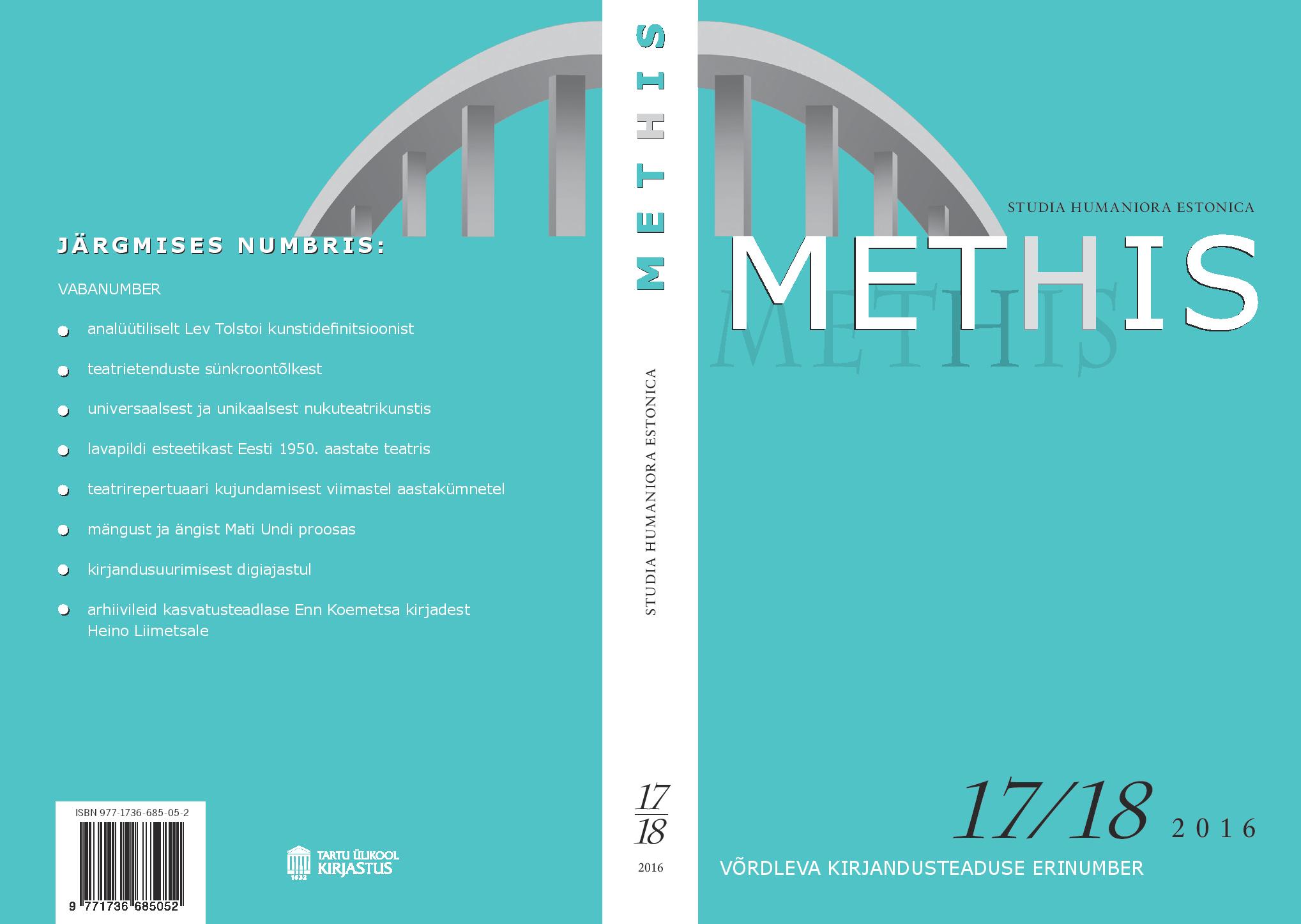Jüri Talvet maailmaluule tõlgendajana / Jüri Talvet’s Interpretations of World Poetry
DOI:
https://doi.org/10.7592/methis.v14i17/18.13211Keywords:
võrdlev kirjandusteadus, poeetika, kirjandusajalugu, esseed, tõlkekirjandus, comparative literary science, poetics, history of literature, essays, translationsAbstract
Teesid: Tartu Ülikooli maailmakirjanduse professori, luuletaja, kirjandusteadlase ja hispaaniakeelse kirjanduse spetsialisti Jüri Talveti tõlketegevuse viljade hulka kuulub luulet ja proosat nii sajandeid vanast Hispaania klassikast kui ka 20. sajandil või tänapäeval romaani keeltes või inglise keeles loodud teostest. Käesolev artikkel keskendub sellele, kuidas professor Talvet on tõlgendanud luule ja poeetika, kuid ka kirjandusajaloo, iseäranis barokk-kirjanduse alaseid küsimusi oma kirjandusteaduslikes esseedes. Vaadeldakse ka tema tõlketegevuse mahtu ja tõlketöö põhimõtteid.
Jüri Talvet (born in 1945) is a poet and a scholar of comparative literature, Chair Professor of World Literature at the University of Tartu. His numerous translations of poetry and poetical fiction from the Romance languages and, to a lesser extent, from English, reflect his views on world poetry. Those views are also expressed in his theoretical writings from the years of 1977 to 2015. Having studied English literature as the main subject at the University of Tartu, he early developed an interest in Spanish, in other Iberian languages, and in the Iberoamerican literatures. His translations from that area include works from medieval and early modern literature as well as notable literary achievements from the 20th century and the contemporary era. Talvet’s interpretations of Federico García Lorca and the “Latin American boom” authors are supported by profound insights into the philosophy, aesthetics, and poetics of the 17th century Spanish Baroque literature, known as the literary Golden Age of Spain. The influence which Talvet’s activities have exerted has widened the horizons of Estonia’s literary culture: while in the early 20th century, the previous German, Russian and Finnish leanings were supplemented by orientations to, and translations from, French and Italian literatures, Talvet has helped to enrich the Estonian literary landscape with the mentality and traditions of even more distant language areas, such as Castilian (Spanish), Catalan, Galician, Portuguese, and the Latin American countries. In the section “Quevedo and Góngora” of this article, Talvet’s interpretation of some of the key issues of dispute in the Baroque literature of Spain are studied, based both on his theoretical essays and on his translations of the poetry of Francisco de Quevedo. Talvet has attempted to use the terms of the Baroque philosopher and writer Baltasar Gracián, agudeza, concepto (definable approximately as “conceit” or “wit”) and conceptismo, for the analysis of the late 20th century Estonian poetry. On that background, defnitions of conceptismo and cultismo (the other main school in Spanish Baroque poetry) are offered in this article, with implications that those definitions may have for understanding different styles and methods of poetry in general, and the characteristics of Talvet’s own poems and poetry translations in particular. To escape diffusion in pure sensuality and verbal indulgence, poetry has to rely on concepts as well as images. Talvet’s interpretations of poetry and poetical thinking are found to be close to conceptismo, or with a considerable amount of conceptuality inherent to them. The juxtaposition of paradoxical ideas from different levels of reality, social and psychic, is seen as the essential poetical method that Talvet refers to as he defines, quoting Yuri Lotman, the structural-semantic code of poetry as being “paradigmatic”. In the final section of the article, Talvet’s 23 book-length published translations are listed, including translations from Spanish, Catalan, English and French. The list does not include numerous translations of single poems or cycles of poetry that have appeared in literary journals, nor his contributions to anthologies of poetry, nor the translations from his native Estonian into a foreign language, such as Spanish or English, in which he has participated. His translations encompass lyrical works as well as fiction and plays. Talvet has translated classical European poetry, such as the sonnets of Petrarch and Quevedo and Provençal poems, as well as the rhymed poems of American poets into Estonian with complete metrical correspondence and full rhymes. However, in the latest decades Talvet has expressed scepticism in the sense and feasibility of attempting to convey the rhyming complexities of the major European literatures into Estonian, a language with a considerably smaller potential for finding full rhymes. Accordingly, his three translations of Spanish Baroque drama (by Calderón and Tirso de Molina) employ a liberal method of versification. In all his versatile activities as a poet, a translator, and a theorist of poetry, Professor Talvet has shown great devotion to developing and cultivating aesthetic values. A lot of his colleagues and students have benefited from his friendly advice. Thinking of his contributions to Estonia’s literary tradition, one may repeat and paraphrase the sentence that he used for the conclusion of his essay on the Catalan poet Salvador Espriu in 1977: “to write (and to translate) poetry is to work for the benefit of the people.”


